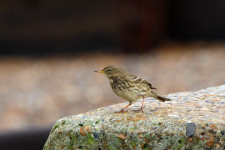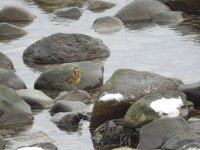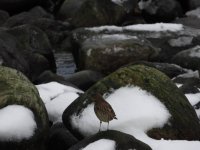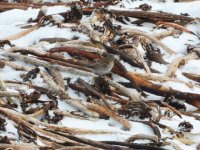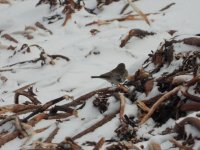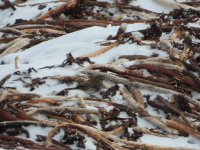Hello Redmist,
yes first bird is a Rock Pipit. Its a pale legged bird at the extreme end of variation but you can clearly see the right dark velvet-pinkish hue "shining through" and the other features you mentinend.
Second bird is harder imo. Its eiter a Rock or a Water Pipit. I assume it was taken in winter(snow?), but it shows some features of a Water Pipit:
-clear bright white belly, breast and vent.
-whitish wingbars
-streaks to underparts are absent on the flank
- streaks to breast dont appear (difficult to judge) smudged, washed out, broad enough for an ID-book Rock Pipit, but this pattern is just within variation for Rock Pipit I think I remember information that Scandinavian Rock Pipits are similar to Water Pipit in some features)
On first impression, back is better for Water with nearly unstreaked grey-brown back, but it has olive hues there, that are good for Rock Pipit. I havent enough experience there, but it is very rare at best for Water Pipit.
Are there more pictures, where streaking to the breast, head pattern and colour of the back from a different agle can be judged?
If only the streaks to the flanks were sharper, nrrower and pencil-like, and colour of back was a liile bit greyer, warmer, paler and more sand-coloured, I would id it as a Water Pipit.
But the above mentioned caveats make me ask for more pictures. I cant decide between a Water Pipit and an extremly "Water Pipit"-like Rock Pipit, because of olive tinged upperparts and slightly smudged and broad streaks to the flanks.
But the bright white undertail-coverts and unmarked rear flanks are perfect for a Water Pipit. And I dont know, if this bird has a greyer nape contrasting to olive-brown nape, or not.
But with such unmarked bright white vent and belly and what
appears to be isolated quite sharp streaks to the breast and some clear brown tone shown to rear back and slightly greyer head, I am in the Water Pipit camp for this with the caveat that colours arent completly accurate in this picturec and it might be a Rock Pipit, see here:
https://www.ntbc.org.uk/wp-content/uploads/2013/06/Water-Rock-Pipit.pdf
I have seen the olive hue on two different screens!

